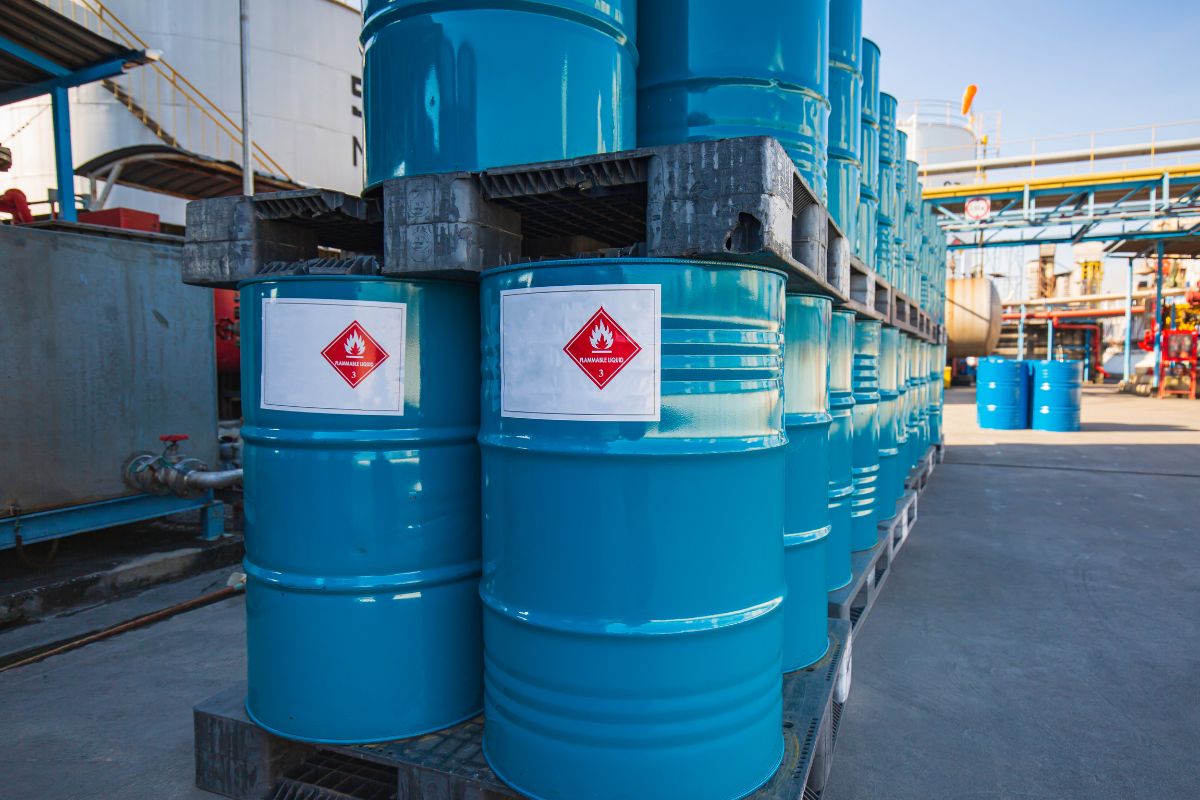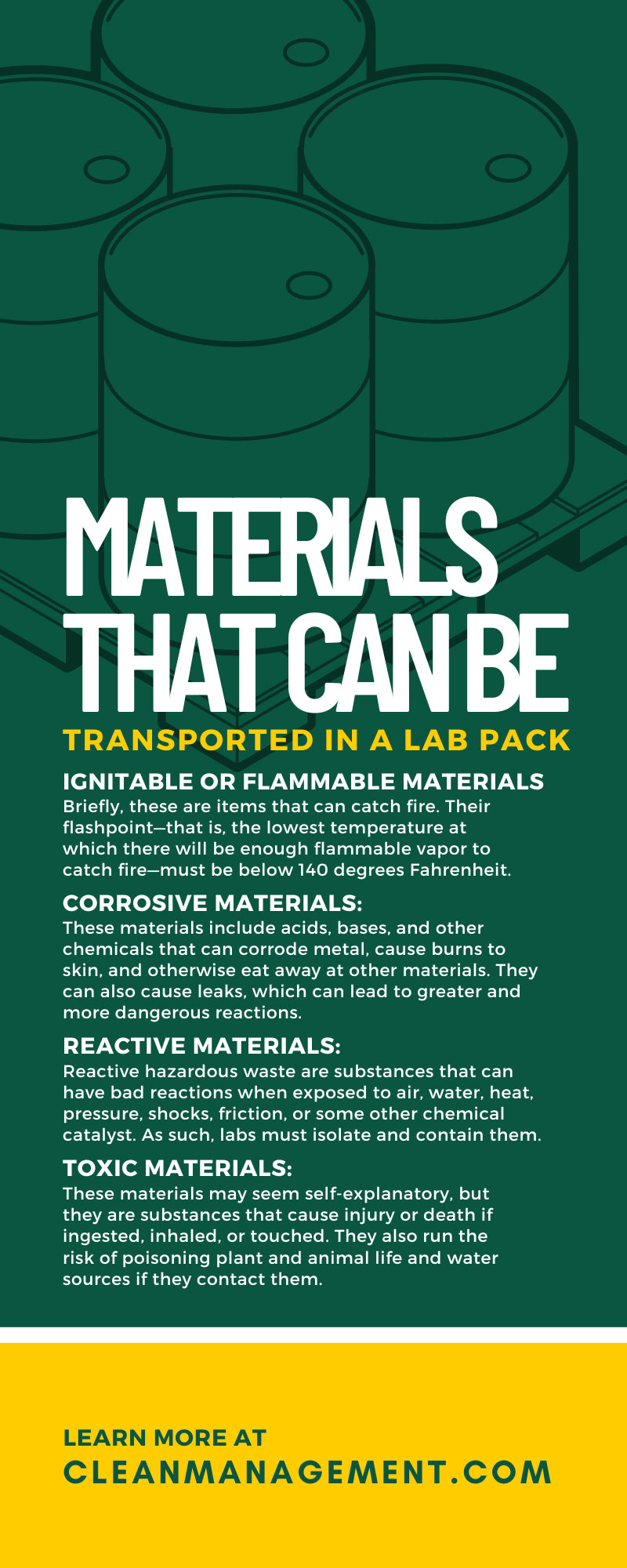4 Materials That Can Be Transported in a Lab Pack

Hazardous materials require special disposal methods, and some materials require even more specialized handling before disposal. Lab packs, for example. Lab packs ensure that specific substances won’t explode, ignite, spill, or otherwise injure or kill anyone when businesses pack, transport, and dispose of them. The Department of Transportation (DOT) regulates lab packs, establishing rules regarding hazardous material disposal to protect the public and the environment. The DOT may subject those companies and individuals who fail to follow these requirements to fines and other penalties. Here are four materials that can be transported in a lab pack and other facts and information about them.
What’s in a Lab Pack?
First, let’s explore what makes up a lab pack. The term lab pack is self-explanatory, reflecting the chemicals, substances, and waste products laboratories generate and need packed away and disposed of. That said, the lab pack itself is a simple thing. It’s a container, most often a 55-gallon steel or fiber drum, containing smaller canisters of chemicals separated according to their status as hazardous materials—including oxidizers, flammable materials, acids, and others.
Vermiculite surrounds each canister within the drum for added safety. Vermiculite is an absorbent material frequently used in insulation. Its squishiness and absorbency are great for keeping hazardous materials dry, preventing contact with water and other chemicals, and reducing the risk of heavy jarring or jostling. Labels, applied to the lab packs after packing and sealing, indicate their contents. Finally, the packs are ready for shipping. Those shipping the lab packs should organize and consolidate them before shipping them to their destinations, whether the destination is long-term storage, the landfill, or other disposal process—such as incineration, neutralization, stabilization, blending, or another method.
What Materials Go in a Lab Pack?
We’ve touched on the characteristics of several examples of hazardous waste already, but they break down into four main types—ignitable waste, corrosive waste, reactive waste, and toxic waste. These types of waste can include all sorts of chemicals and objects containing such chemicals. Specifically, hazardous waste that one must put into lab packs before transporting them includes:
- Ignitable or Flammable Materials: Briefly, these are items that can catch fire. Their flashpoint—that is, the lowest temperature at which there will be enough flammable vapor to catch fire—must be below 140 degrees Fahrenheit.
- Corrosive Materials: These materials include acids, bases, and other chemicals that can corrode metal, cause burns to skin, and otherwise eat away at other materials. They can also cause leaks, which can lead to greater and more dangerous reactions.
- Reactive Materials: Reactive hazardous waste are substances that can have bad reactions when exposed to air, water, heat, pressure, shocks, friction, or some other chemical catalyst. As such, labs must isolate and contain them.
- Toxic Materials: These materials may seem self-explanatory, but they are substances that cause injury or death if ingested, inhaled, or touched. They also run the risk of poisoning plant and animal life and water sources if they contact them.
Getting even more specific, chemicals that require lab packing can include medical waste, aerosols and compressed gases, radioactive materials, cleaners and disinfectants, strippers and solvents, reagents, drugs, dyes and paints, unidentified substances, and more. A comprehensive list is impossible for the purposes of this article, but those previously mentioned should cover the gist of it. In short, lab packing is necessary to keep such substances stable and out of contact with each other to avoid explosions, fires, poisoning, and other negative reactions.
Other Rules and Regulations
The DOT handles the rules on lab packing and disposal because labs will be transporting the materials by vehicle, train, or other methods. However, the Environmental Protection Agency (EPA) also has a say in ensuring labs and other businesses handle, store, and dispose of hazardous materials properly. The EPA’s satellite location in the state or states through which hazardous materials travel may also require other rules or the issuance of permits for transportation. What’s more, those who prepare lab packs must receive training and certification to comply with the above rules. Those who prepare the packs must also wear the correct personal protective equipment (PPE) while handling and packing the waste. Lab pack labels must feature the lab pack’s contents, the name and address of the shipper, contact information for all parties involved, and similar identification in case of emergencies.
Lab Packing…Who Needs It?
As it turns out, many companies do, and they’re not all laboratories in the classic sense of bubbling beakers, test tubes, and Erlenmeyer flasks.
- Colleges, universities, and high schools: Their science labs usually generate their share of hazardous wastes that they can’t just pour down the drain or toss out with the trash. Special waste-hauling professionals can lab pack the byproducts of all those students’ experiments and take them away.
- Healthcare Facilities: Labs exist in hospitals, clinics, and other places where the sick seek treatment. Some of the above hazardous wastes need disposal, as do materials that encounter pathogens. Some items like used syringes and other sharps require special handling and disposal, though they may not require lab packing.
- Manufacturers: Industrial waste is an ongoing concern. While it was common practice for factories and other facilities to dump their waste around the property or pour it into nearby bodies of water, clearly, that’s not the best solution. Lab packing bundles up and carts off waste that can harm the environment and the surrounding community.
- Dry cleaners: Yes, even cleaners produce their share of hazardous waste. They must lab pack, remove, and dispose of used chemical solutions like perchloroethylene elsewhere where it can’t harm anyone.
Looking for a Lab Pack Company?
We’ve learned about four materials that can be transported in a lab pack, specific substances that fit the bill, who sets the rules for lab packing, and who has the most need for it. Contact us for a consultation today if you have questions about lab pack services and other industrial cleaning services and solutions. We’ve been in business for over 30 years. Though our headquarters is in South Carolina, we offer our services to companies and organizations across the United States of America. Visit our website for more information on our services and expertise!

